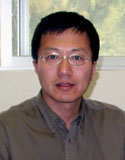为了让广大师生更好地了解互联网技术的发展现状,提高广大师生的网络知识水平,工学部网络工程教研室将连续举办三场专题讲座,欢迎广大师生参加。
时间:7月12日(星期三)13:30
地点:19号楼301会议室
主办:工学部计算机与通信工程学院网络工程教研室
讲座一:Minimum Cost Deployment of HeterogeneousDirectional Sensor Networks for Differentiated Target Coverage
主讲人:陈学敏,副教授、美国德州南方大学工程系虚拟与远程实验室主任

主讲人简介:
Dr. Xuemin Chen is the founding Director ofVirtual and Remote Laboratory(VR-Lab)and anAssociate Professor of Electrical and Computer Engineering at the TexasSouthern University(TSU). Hereceivedhis BS, MS and Ph.D. degrees in Electrical Engineering from the NanjingUniversity of Science and Technology (NJUST), China, in 1985, 1988 and 1991respectively. He joined the faculty of TSU in the Department of EngineeringTechnology in September 2006. Prior to that, he had fifteen years workingexperience in academia with six years at NJUST and another nine years atUniversity of Houston. He was the recipient of the Top Research Innovations andFindings Award from Texas Department of Transportation (TxDOT) for hiscontribution in the “Thickness Measurement of Reinforced Concrete Pavement byUsing Ground Penetrating Radar” in 2004. Upon joining the TSU, he activelyengaged in the conception and implementation of next-generation remotelaboratory. He initiated the Virtual and Remote Laboratory at TSU in 2008. Withthe support of NSF HBCU-UP, CCLI and IEECI programs, and Qatar NPRP award, he hasestablished a state of the art VR-Lab at TSU. His research interests are inwireless sensor networks, virtual and remote laboratory, networked controlsystem and structural health monitoring. He is an investigator of NSF Centerfor Research on Complex Networks at TSU.
讲座简介:
A basic deployment goal of a directionalsensor network (DSN) is to satisfy the coverage quality requirements of thetargets. The limited sensing angle of directional sensors makes the deploymentof such a network more complicated than that of an omnidirectional sensornetwork. In some emerging DSN applications, the targets may have differentiatedcoverage quality requirements due to their differentiated importance orpriorities. Meanwhile, directional sensors of multiple types with differentsensing ranges and prices are available for optimally organizing a network. Todeploy such a DSN with satisfied network connectivity under the minimum costconstraint is a significant problem to be solved. In the presentation, weformulate and address the problem for the first time. First, we prove itsNP-completeness. Then, this problem is formulated as an integer linearprogramming model. To solve it approximately, we propose three algorithms,i.e., a greedy heuristic, local search, and particle swarm optimization.Extensive numerical experiments are conducted to validate the proposedalgorithms. The results suggest that the proposed algorithms can effectivelysolve the problem, and the last one can achieve both the highest success rateand the best solution quality.
讲座二:Several Challenging Problemsin Wireless Networks Research
主讲人:李伟,教授、美国德州南方大学计算机科学系NSF以及复合网络研究中心主任

主讲人简介:
Dr. Wei Li is a Professor in theDepartment of Computer Science at Texas Southern University (TSU),Houston, USA. He is also the founding Director/PI of NSF Center for Research onComplex Networks at TSU, one of 27 active NSF Centers of Research Excellence inScience and Technology (CREST) in 2017. Before joining TSU, Dr. Li was anAssociate Professor with tenure in the Department of Electrical Engineering andComputer Science at the University of Toledo, USA, and was once also anAssociate Professor in the Department of Operations Research at the ChineseAcademy of Sciences, Beijing, China. His research interests are in wirelesssensor networks and mobile ad hoc networks; adaptation, design, andimplementation of dynamic models for wireless and mobile networks; radioresource allocations in wireless multimedia networks; and mobile andhigh-performance computing etc. He is the author/co-author of 5 books and over150 peer-reviewed papers in professional journals and the proceedings ofconferences, including IEEE TC, IEEE TWC, IEEE TVT, IEEE/ACM TN, IEEE JSAC, andINFOCOM et al. During last ten years, his research activities have beensupported as Principal Investigator (PI) for over $6 million by five NSFResearch Grants, two AFOSR Grants and one Industry Project. He is currentlyserving as an Editor for three professional journals, is serving or has servedas a Steering Committee Member/ General Co-Chair/ TPC Co-Chair/ PublicityChair/ Session Chair/ TPC members respectively for a number of professionalconferences, such as INFOCOM, Globecom, ICC, and WCNC et al.
讲座简介:
In this presentation, the speaker willpresent three recent research results in wireless networks. One is in bandwidthadaptation of wireless networks by using network reversible process property.This research verifies the product-form solution of whole wireless network andfurther reveals the importance of single-node research in wireless networks.Another research is in call admission control based billing strategies by usingthe method of Markov decision process. This research verifies the optimal admissionthreshold policy for new generated data and then provides a novel method inresolving dynamic optimal problems in wireless networks. The third research ison the investigation of joining strategies of Second Users (SUs) in a cognitiveradio system with a single Primary User (PU) band that enables SUs to utilizethe unused spectrum band originally allocated to a PU opportunistically. Thisresearch derives the Nash Equilibriums for non-cooperative joining strategy andcooperative joining strategies, respectively. By observing that an individuallyoptimal strategy does not yield the socially optimal strategy, this researchfurthermore proposes an appropriate admission fee strategy imposed on the SUsand then successfully bridge the gap between the individually and sociallyoptimal strategies. As a potential collaboration with scholars who areinterested in these areas, the speaker will discuss a few challenging problemsin the areas which may need to be paid attention in the near future. Finally,the speaker will present on how the current research be linked to the shortrange wireless communications for connected vehicle to vehicle (V2V) networks.
讲座三:RoboticExoskeletons for Human Rehabilitation
主讲:余文,教授、墨西哥国立理工学院系主任

主讲人简介:
WenYu received the B.S. degree from Tsinghua University, Beijing, China in 1990and the M.S. and Ph.D. degrees, both in Electrical Engineering, fromNortheastern University, Shenyang, China, in 1992 and 1995, respectively. From1995 to 1996, he served as a Lecturer in the Department of Automatic Control atNortheastern University, Shenyang, China. Since 1996, he has been withCINVESTAV-IPN (National Polytechnic Institute), Mexico City, Mexico, where heis currently a Professor with the Departamento de Control Automatico. From 2002to 2003, he held research positions with the InstitutoMexicanodelPetroleo. Hewas a Senior Visiting Research Fellow with Queen’s University Belfast, Belfast,U.K., from 2006 to 2007, and a Visiting Associate Professor with the Universityof California, Santa Cruz, from 2009 to 2010. He also holds a visitingprofessorship at Northeastern University in China from 2006. Dr.Wen Yu servesas associate editors of IEEE Transactions on Cybernetics, Neurocomputing, andJournal of Intelligent and Fuzzy Systems. He is a member of the Mexican Academyof Sciences.
讲座简介:
Exoskeletons could be regarded aswearable robots, which are worn by the human operators as orthotic devices. Theadoption of a purely positional control strategy may lead to the build up oflarge forces (both external and internal). Hence, an impedance control strategyis devised aimed at limiting both internal and contact forces. The desiredtrajectory is trained in joint space without the dynamic time warping. We usetwo techniques, Lloyd's algorithm and modified hiddenMarkov model, to solve the problems in joint space learning. Since the desiredtrajectories are the joint angles, they can be applied directly without inversekinematics. Experimental results show that the proposed algorithm works wellfor human behavior learning.









